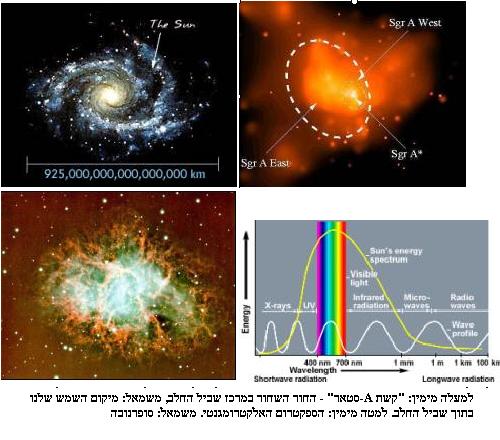An international team of researchers managed to penetrate through the clouds of interstellar dust, observe the halo of the black hole at the center of the Milky Way and discover its size
Michael Rosenberg

(Published in "Globes" on August 17-18, 2004)
Direct link to this page: https://www.hayadan.org.il/sgra190804.html
In an article recently published in the journal "Science", data were revealed with unprecedented accuracy about the black hole at the center of the Milky Way. About thirty years after radio wave radiation from a mysterious object in the center of our galaxy was first discovered, an international team of researchers led by Jeffrey Bauer from the University of California "Berkeley" managed to reveal its size. So this is the news: the size of the object, whose mass is 4 million times greater than the mass of our sun, does not exceed the orbital path of the planet Hema (Mercury). Such a tremendous mass density is called a "black hole" - one of the strangest phenomena in the study of the universe. It is a mass of such high density that its tremendous gravity distorts and "tears" the dimensions of space and time. Particles of matter and light that get too close to a black hole cross a "threshold of no return", from which the only possible direction is - inward. The hole is black because nothing can escape from it, not even light. Theoretically, the time dimension inside a black hole can move back and forth. There are even scientists who speculate that the center of a black hole is a corridor to other universes. The black hole located right in the center of our galaxy is called the "Sagittarius A-star" (Sgr A*) - because its location is in the Sagittarius constellation.
The study of black holes has undergone several surprising upheavals in the last decade. General relativity and theories about the processes of nuclear combustion in stars predicted the existence of "stellar black holes". These black holes are created from the collapse of stars that are tens of times the mass of our sun after they have finished burning, during a massive explosion known as a "supernova". The supernovas are a spectacular show of light flashes that appear in the sky for only a few months and then disappear. Another type of black holes is a "massive black hole" which was discovered in the center of distant galaxies and until recently was considered rare. These black holes have a huge mass - millions of times the mass of a stellar black hole. There is still no plausible theory about how they are formed.
A black hole swallows everything that falls into it and emits nothing, meaning the hole itself cannot be seen. However, the falling material, just before it is "sucked" into the hole, is accelerated, compressed, heated to the point of crystallization, and emits enormous amounts of light. So paradoxically, the blackest object in the universe finds itself surrounded by a gas halo that shines like no other. One of the missions of the "Hubble" space telescope launched in 1990 was to study massive black holes and the galaxies in which they reside. The surprise was not long in coming - the space telescope discovered a massive black hole in every galaxy it could observe. Today, researchers already believe that at the center of every galaxy in the universe there is a massive black hole. This hypothesis made the mysterious object at the center of our galaxy a desirable research object, since it is the closest massive black hole to Earth - a distance of 26 thousand light years. The location of "Hubble" at the edge of the Earth's atmosphere allows it to overcome the disturbances and distortions of vision in the atmosphere. However, in order to observe the direction of the black hole at the center of the Milky Way, a different obstacle must be overcome - the clouds of interstellar dust that hide its surroundings.
The clouds of interstellar dust block the light, blur the resulting image (as if it were not "in focus") and do not allow to see the halo of hot gas that surrounds the black hole. Viewing in the radio wave field is able to circumvent this problem. For this, the astronomers use radio telescopes, which are shaped like giant satellite dishes. These telescopes pick up light particle radiation at low frequencies that are not visible to the eye. In fact, all the radiations we know are nothing but the movement of light particles in space, at different wavelengths. Visible light in its various colors is only a small part of the spectrum of electromagnetic radiation that spreads from radio waves that are kilometers long to X-rays and gamma rays that have a wavelength of less than a billionth of a centimeter. The radio waves manage to overcome the clouds of interstellar dust, as, for example, infrared telescopes "see" in the dark. The most sophisticated radio telescope network currently available to researchers belongs to the US National Science Agency. This network (VLBA), has ten giant radio telescopes spread across the US from Puerto Rico in the east to Hawaii in the west. The international team of researchers led by Professor Bower conducted intensive radio observations towards the black hole at the VLBA for several years. To overcome the "blurring problem", the team pushed the radio telescopes to the limit of their capabilities - the microwave frequencies - and developed new data processing techniques. The effort bore fruit and the observations revealed the size of the gas halo - no more than five times the size of the black hole itself. Now the researchers are facing the last challenge - to penetrate through the halo of luminous gas and see the shadow of the black hole itself on the surface of the inner part of the halo.
For an article on this subject from the BBC
Image of the black hole region taken by the Chandra telescope in January 2003
